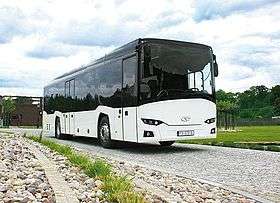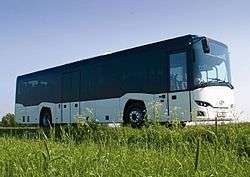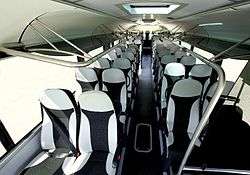Solaris InterUrbino 12
The Solaris InterUrbino 12 is a single-decker intercity bus from the series InterUrbino by Solaris Bus & Coach produced since 2010 onwards.
| Solaris InterUrbino 12 | |
|---|---|
 | |
| Overview | |
| Manufacturer | Solaris Bus & Coach |
| Production | 2010–present |
| Assembly | Bolechowo, Poland |
| Body and chassis | |
| Class | Single-decker intercity bus |
| Doors | 2 doors |
| Floor type | Step entrance |
| Powertrain | |
| Engine | 1) Iveco N60 ENT 220 EEV 2) Cummins ISB6,7E5 300 3) Cummins ISB6,7EEV 300 4) DAF PR265 U1 (Euro 5) 5) DAF PR265 U2 (EEV) |
| Capacity | 55 seated |
| Transmission | Eaton FSO 8406 ZF 6S1010BO Allison Torqmatic ZF EcoLife 6AP 1700B Voith DIWA 5 |
| Dimensions | |
| Length | 11995 mm |
| Width | 2550 mm |
| Height | 3100 mm 3300 mm (with air conditioning) |
| Curb weight | 18000 kg |
History


The official Polish premier of the model InterUrbino 12 occurred on the 16 September 2009 on the Transexpo Trade Fair in Kielce.[1] Whereas the European premier happened in October of the same year on the Busworld Kortrijk Trade Fair in Belgium. The vehicle was already on the road in Bydgoszcz and Gliwice, where various driving tests occurred, the photograph shoots had been in Olsztyn.
In 2009 the first two prototypes. In the first half of 2010 there were meant to be 10 prototypes which would have undergone extensive tests and crash exploitation tests (the amount of them built is not known). The series production began in the second half of the year. The production line is able to produce 450 buses per year, 70 of them would stay in Poland.
The prototypes undergone extensive tests on the Tatra test track in Kopřivnice and on the test track of the Wabco company in Rovaniemi in Finland in the Arctic Circle. The tests included driving in extreme atmosphere, with temperatures dropping to -30˚C. The buses had undergone various durability tests including the elk drive, rough and harsh turns and taking the vehicle on turning extremes, with and without using the route stabilisation ESC, also checking the bus' reaction to sharp turns.[2]
In 2010 the first twenty produced buses were delivered to France.
There are future variations of the InterTurbino where the bus is longer, with the length of 15 metres, with three wheel axis. In June 2012 the second model of the series debuted, the two wheel axis Solaris InterUrbino 12,8.[3] After this the whole series had a new interior design makeover, with a bow type design by the Berlin designers StudioFT. The Cummins engine is fitted with the OBD2 system.
The electrical installation is fitted with LED lighting. This covers the integrated lighting in the daytime, anti-fog lights, integrated baggage shelves, indicators, lights and interior lights.
Together with the modernisation a new option is offered, with the classic design option, with the interior passenger premium design. This includes the lighting on the ceiling, integrated baggage shelves and an individual instrumental panel with a ventilation system by each chair.[4]
References
- Kierecki, Aleksander. "TRANSEXPO 2009: Solaris and premier InterUrbino". Infobus. Retrieved 6 December 2014.
- -, -. "Tatra Track Poland Czech Republic". Phototrans. Retrieved 6 December 2014.CS1 maint: numeric names: authors list (link)
- Kierecki, Aleksander. "Solaris na wystawie Transport Publics w Paryżu". Infobus. Retrieved 6 December 2014.
- -, -. "Contact Page". Solaris Bus and Coach. Retrieved 6 December 2014.CS1 maint: numeric names: authors list (link)